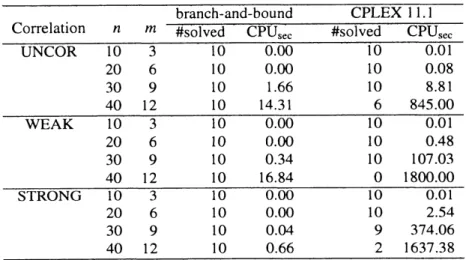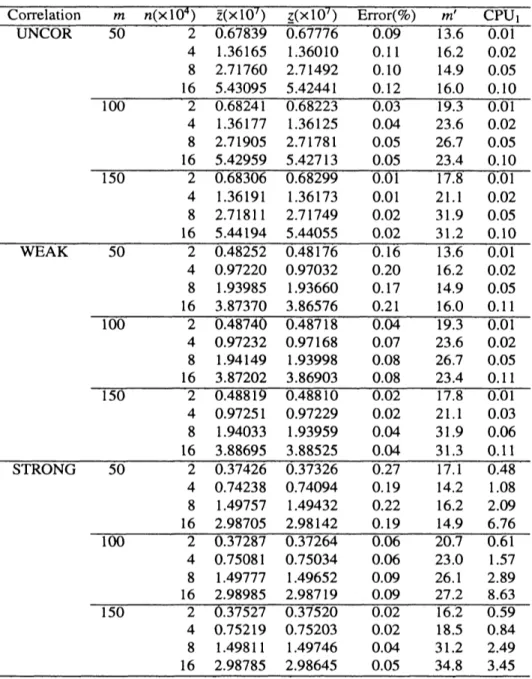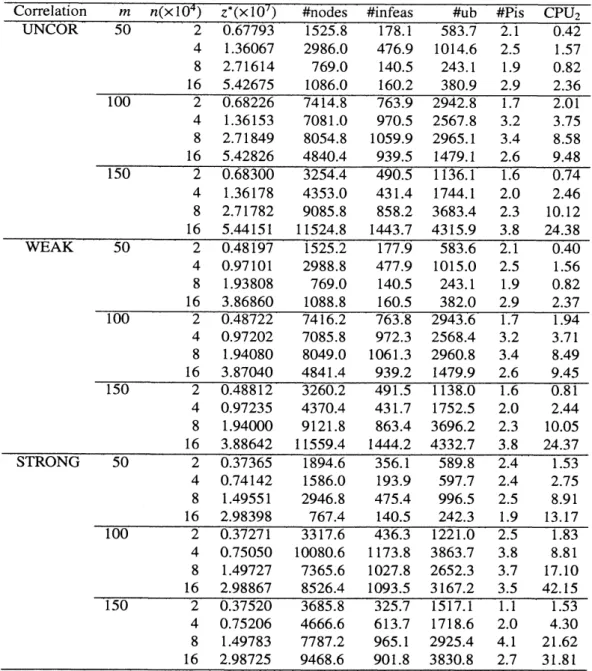An
exact
algorithm for the budget-constrained
multiple knapsack problem
Department of
Computer
Science,
The National
Defense
Academy
Yokosuka,
Kanagawa 239-8686, Japan
Byungjun
You,
Takeo Yamada
{g48095,
yamada}@nda.ac.jp
1
Introduction
This
paper
isconcemed witha
variationof the multiple knapsack problem (MKP) [5, 6],wherewe
are
givena
setof $n$ items $N=\{1,2, \ldots, n\}$ to be packed into $m$ possible knapsacks $M=\{1,2, \ldots, m\}$. As in ordinaryMKP,by $w_{j}$ and $p_{j}$ wedenote the weight and profit of item$j\in N$ respectively, and the capacityof knapsack
$i\in M$ is$c_{j}$. However,a fixedcost$f_{i}$ is imposed if
we use
knapsack$i$, andknapsacksare
freely available withinafixed budget $B$
.
The problem istodetermine thesetof knapsackstobe employedas
wellas tofill theadopted knapsacks with items such thatthecapacity constraintsareall satisfied and thetotal profit is maximized. Let $y_{i}$ and$x_{ij}$be the decision variables such that$y_{i}=1$ if
we use
knapsack$i$, and$y_{i}=0$otherwise. Also,$x_{ij}=1$ if item $j$ is put into knapsack $i$, and
$x_{ij}=0$ otherwise. Then, the problem is formulated
as
the followingbudget-constrained multiple knapsackproblem.
BCMKP:
maximize $\sum_{i=1}^{m}\sum_{j=1}^{n}p_{j^{X}ij}$ (1)
subjectto $\sum_{j=1}^{n}w_{j}x_{ij}\leq c;y_{i}$, $i\in M$, (2)
$\sum_{i=1}^{m}x_{ij}\leq 1$, $j\in N$, (3)
$\sum_{i=1}^{m}f_{i}y_{i}\leq B$, (4)
$x_{ij},$ $y_{i}\in\{0,1\}$, $i\in M,j\in N$. (5)
Throughoutthe paper we
assume
the following.$A_{1}$. Problem data
$w_{j},$ $p_{j}(j\in N),$ $c_{i},$ $f_{i}(i\in M)$and $B$are allpositive integers.
$A_{2}$. Items
are
arrangedinnon-increasingorderof profitperweight, i.e.,$p_{1}/w_{1}\geq p_{2}/w_{2}\geq\ldots\geq p_{n}/w_{n}$. (6)
A3.
Knapsacksare
numberedin non-increasingorderofcapacitypercost,i.e.,$c_{1}f_{1}\geq c_{2}f_{2}\geq\ldots\geq c_{m}’ f_{m}$. (7)
BCMKP is NP-hard [3],since the special
case
of free knapsacks$(f_{i}\equiv 0, \forall i\in M)$ is simplyanMKP whichis already NP-hard. Since BCMKP isalinear0-1 programmingproblem, small instances
can
besolved using MIP(mixedintegerprogramming) solvers. In thisarticle,we
presentan
algorithmthat solves largerBCMKPs2
Upper bound
Thissectionderives
an
upperboundby applyingtheLagrangian relaxation[2]toBCMKP. Withnonnegativemultipliers $\lambda=(\lambda_{i})\in R^{m}$ and$\mu\in R$ associated with (2) and (4) respectively, theLagrangian relaxation to
BCMKPis LBCMKP$(\lambda,\mu)$
:
maximize $\sum_{i=1}^{m}\sum_{j=1}^{n}(p_{j}-\lambda_{i}w_{j})x_{ij}+\sum_{i=1}^{m}(\lambda_{i}c_{i}-\mu f_{i})y_{i}+\mu B$ (8)
subject to (3), (5).
For$\lambda\geq 0,$$\mu\geq 0$, let$\overline{z}(\lambda,\mu)$ denote the optimal objective valuetoLBCMKP$(\lambda,\mu)$
.
Then, it is easily provedthat$\overline{z}(\lambda,\mu)$gives an upperboundto BCMKP, and$\overline{z}(\lambda,\mu)$is
a
piecewise linear andconvex
function of$\lambda$and$\mu$. Moreover,ifweconsider the Lagrangian dual
minimize $\overline{z}(\lambda,\mu)$ subjectto $\lambda\geq 0,\mu\geq 0$,
we
have thefollowing.Theorem1 Thereexistsanoptimalsolution$\lambda^{\dagger}=(\lambda_{i}^{\dagger})$ tothe Lagrangian dual suchthat$\lambda_{1}^{\dagger}=\lambda_{2}^{\dagger}=\ldots=\lambda_{m}^{\dagger}(\equiv$
$\lambda^{\dagger})$.
Proof. Fora fixed $\lambda=(\lambda_{i})\geq 0$, let $k$ $:= \arg\min_{i\in M}\{\lambda_{i}\}$
.
Then, since $p_{j}-\lambda_{i}w_{j}\leq p_{j}-\lambda_{k}w_{j}$ for all $i\in M$and$j\in N$, the objective function (8) is maximized by setting $x_{ij}=1$ if and only if$i=k$ and$p_{j}-\lambda_{k}w_{j}>0$
.
Similarly,$y_{i}=1$ if and only if$\lambda_{i}c_{i}-\mu f_{i}>0$, and
we
obtain$\overline{z}(\lambda,\mu)=\sum_{j=1}^{n}(p_{j}-\lambda_{k}w_{j})^{+}+\sum_{i=1}^{m}(\lambda_{i}c_{i}-\mu f_{i})^{+}+\mu B$, (9)
where $(\cdot)^{+}$ $:= \max\{\cdot, 0\}$
.
Here, we note that $(\lambda_{i}c_{i}-\mu f_{i})^{+}$ is monotonically non-decreasing with respect to $\lambda_{i}(i\neq k)$. Thus, under thecondition$\lambda_{i}\geq\lambda_{k},$ (9) is minimizedat$\lambda_{i}\equiv\lambda_{k}(i\in M)$. 1From thistheorem, it sufficestoconsiderthe
case
of$\lambda_{i}\equiv\lambda(\forall i\in M)$,andthus$\overline{z}(\lambda,\mu)$ is rewrittenas
$\overline{z}(\lambda,\mu)=(C_{t}-W_{s})\lambda+(B-F_{t})\mu+P_{s}$. (10)
Here $s$ and $t$
are
the critical valuesdefinedas
$s$ $:= \max\{j|p_{j}-\lambda w_{j}\geq 0\}$ and $t$ $:= \max\{i|\lambda c_{i}-\mu f_{i}\geq 0\}$respectively, and $W_{s}$ is the accumulated weight given by$W_{s}$ $:= \sum_{j=1}^{s}w_{j}$
.
$P_{s},$$C_{t}$ and$F_{t}$areanalogously definedfor $(p_{j}),$ $(c_{i})$ and $(f_{i})$, respectively. Forafixed$\mu\geq 0,$ (10) isa piecewise linear function of$\lambda$, and its gradient
changes from$C_{t}-W_{s}$to $C_{t}-W_{s-1}$ as$\lambda$increases from$p_{t}w_{s}-0$to$p_{s}w_{s}+0$. Similarly, the gradientincreases
from$C_{t-1}-W_{s}$to $C_{t}-W_{s}$ at$\lambda=(f_{t}c_{t})\mu$
.
Thus,we
obtaintheoptimal$\lambda$as$\lambda^{\dagger}(\mu)=\{\begin{array}{ll}p_{s}’ w_{s}, if W_{s-1}\leq C_{f}\leq W_{s},(f_{t}’ c_{t})\mu, if C_{t-1}\leq W_{s}\leq C_{t}.\end{array}$ (11)
Putting this into (10), $\overline{z}(\lambda^{\dagger}(\mu),\mu)$ is also piecewise linear with respect to
$\mu$, and by bisection method
we
obtain
an
optimal$\mu^{\dagger}$ and $\lambda^{\dagger}$$:=\lambda^{\dagger}(\mu\dagger)$,andcorrespondingly
an
upperbound$\overline{z}=\overline{z}(\lambda^{\dagger}(\mu^{\dagger}),\mu^{\dagger})$. Letus
introduce thethresholdsas
$\theta_{j}:=p_{j}-\lambda^{\dagger}w_{j}$, $\eta;:=\lambda^{\dagger}c_{i}-\mu^{\dagger}f_{i}$. (12) Then, from(9)theLagrangianupperboundis givenas
$\overline{z};=\overline{z}(\lambda^{\dagger},\mu^{\dagger})=\sum_{j\in N}\theta_{j}^{+}+\sum_{i\in M}\eta_{i}^{+}+\mu^{\dagger}$
3
Problem reduction
Assume that we have the optimal Lagrangian multipliers $\lambda^{\dagger}$
and$\mu^{\dagger}$ with the corresponding
upper
bound$\overline{z}$givenby (13),
as
wellas a
lowerbound$\underline{z}$ obtained bysome
heuristic algorithmes. Let$\delta$ be either$0$
or
1, andwe
introduce $P(y_{k}=\delta)$as
the subproblem ofBCMKP with $y_{k}$ fixed at $\delta$. $\overline{P}(y_{k}=\delta)$ denotes theLagrangianrelaxationof$P(y_{k}=\delta)$using the optimal $\lambda^{\dagger}$
and$\mu^{\dagger}$ in (8). Thatis,
$\overline{P}(y_{k}=\delta)$;
maximize $\sum_{j=1}^{n}\theta_{j}x_{j}+\sum_{i=1}^{m}\eta_{i}y_{i}+\mu^{\dagger}B$ (14)
subjectto $x_{j},y_{i}\in\{0,1\},$$\forall j\in N,$$\forall i\in M,y_{k}=\delta$, (15)
where
we
introduce a new 0-1 variable$x_{j}$definedby $x_{j}= \sum_{i=1}^{m}x_{ij}$.
Let $(x^{*},y^{*})$ be
an
optimal solution to BCMKP with $x^{*}=(x_{ij}^{*})$ and $y^{*}=(y_{i}^{*})$.
Then, the following isimmediate.
Theorem2 (Peggingofknapsacks)Forevery$k\in M$,
(i) If$\eta_{k}>0$and$\overline{z}-\underline{z}\leq\eta_{k}\Rightarrow y_{k}^{*}=1$,
(ii) If$\eta_{k}<0$and$\overline{z}-z\sim\leq-\eta_{k}\Rightarrow y_{k}^{*}=0$
.
Proof. (i)Note that theoptimal objective value to$\overline{P}(y_{k}=\delta)$ is $\overline{z}(Jk=\delta)$
$:= \sum_{j\in N}\theta_{j}^{+}+\sum_{i*k}’\epsilon M\eta_{i}^{+}+\mu^{\dagger}B+\eta_{k}\delta$
.
Then,comparingthis with (13)
we
have$\overline{z}(Jk=0)=\overline{z}-\eta_{k}\leq\underline{z}$, which implies$y_{k}^{*}=1$ in anyoptimal solution.(ii)is similarly proved. 1
Applying Theorem 2, the knapsacks
are
classifiedintothreedisjoint subsets$K_{0}$ $:=\{i\in M|y_{i}^{*}=0\},$ $K_{1}$ $:=\{i\in$$M|y_{i}^{*}=1\}$ and theremaining $M\backslash (K_{0}\cup K_{1})$
.
Knapsack$i\in K_{0}$ isnever
used, while$i\in K_{1}$ is always used inanyoptimal solutiontoBCMKP.
Similarly, we
can
derivea peggingtheoremforitems, andapplying thisclassifyitems into the disjointsets $I_{0}$ $:=\{j\in N|x_{j}^{*}=0\},$ $I_{1}$ $:=\{j\in N|x_{j}^{*}=1\}$ and$N\backslash (I_{0}\cup I_{1})$. Removing $K_{0}$ and$I_{0}$, BCMKP is reduced(oftensignificantly) insize. In whatfollows,we
assume
that thesearealreadydone, and thus$K_{0}=I_{0}=\emptyset$.4
A branch-and-bound algorithm
A characteristic feature of the branch-and-bound algorithmto begiven below is that branchings
are
madewithrespect tovariables$(y_{i})$irrespectiveto$(x_{ij})$,andthelatteris determined onlyateach terminalsubproblems.
Toconstmct such
a
branch-and-bound algorithm,we
introducea
subproblem ofBCMKPas
follows. Let $F_{0}$and$F_{1}$ betwosubsetsof$M$such that
$K_{0}\subseteq F_{0},$ $K_{1}\subseteq F_{1}$ and$F_{0}\cap F_{1}=\emptyset$.
Theserepresent the setsof knapsacks whicharefixedat$0$and 1,respectively. We considerthefollowing.
$P(F_{0}, F_{1})$: maximize(1) subjectto (2)$-(5)$,and
$y_{i}=0,$ $\vee i\in F_{0}$, $y_{i}=1,$ $\forall i\in F_{1}$
.
(16)Usingtheoptimal $\lambda^{\dagger}$
and$\mu^{\dagger}$ obtainedin Section 2, theLagrangian relaxationtothis problemis
$\overline{P}(F_{0}, F_{1})$; maximize(14) subjectto$x_{j},y_{i}\in\{0,1\},$$\forall j\in N,$ $\forall i\in M$and (16).
Let $z^{*}(F_{0}, F_{1})$ and $\overline{z}(F_{0}, F_{1})$ be the optimal objective values to these problems, respectively. Clearly, $\overline{z}(F_{0}, F_{1})$gives
an
upperboundto$z^{*}(F_{0}, F_{1})$, i.e.,$z^{*}(F_{0}, F_{1})\leq\overline{z}(F_{0}, F_{1})$; andwe
havewhere $U$ $:=M\backslash (F_{0}\cup F_{1})$ is the set of unfixed knapsacks.
Then, if
we
havean
incumbent lower bound $\underline{z}$satisfying$\overline{z}(F_{0}, F_{1})\leq\underline{z}$,
we
canterminate subproblem$P(F_{0}, F_{1})$.Other conditions for pruning subproblems
are
feasibility and dominance. First ofall, if the total cost of acceptedknapsacks is larger than thebudget, i.e., if$\sum_{i\in F_{1}}f_{i}>B,$ $P(F_{0}, F_{1})$is infeasible,and thus terminated.Next, if
we
have knapsacks $(i_{0}, i_{1})\in F_{0}\cross F_{1}$ such that$c_{i_{0}}\geq c_{i_{1}}$ and $f_{i_{0}}\leq f_{i_{}},$ $P(F_{0}, F_{1})$ is again terminated.
Indeed, ifsuch a pair $(i_{0}, i_{1})$ exists,
we
can define a subproblem$P(F_{0}’, F_{1}’)$ by exchanging the role ofthese
knapsacks
as
$F_{0}’$ $:=F_{0}\cup\{i_{1}\}\backslash \{i_{0}\}$ and $F_{1}’$ $:=F_{1}\cup\{i_{0}\}\backslash \{i_{1}\}$. Then, $P(F_{0}, F_{1})$is dominated by$P(F’F’)$, sinceall thefeasible solutionsof$P(F_{0}, F_{1})$
are
feasibleto$P(F_{0}’, F_{1}’)$.$0$’ 1
If$P(F_{0}, F_{1})$ is not terminated by any of these criteria, and in addition if
$U$ is non-empty, we pick up
a
knapsack $i\in U$ and generate two subproblems of$P(F_{0}, F_{1})$ as $P(F_{0}\cup\{i\}, F_{1})$ and $P(F_{0}, F_{1}\cup\{i\})$
.
On theotherhand, if $U=\emptyset,$ $P(F_{0}, F_{1})$ is
a
terminal subproblem. Here, $P(F_{0}, F_{1})$ isan
MKP withrespect to theset
of knapsacks $F_{1}$. An upperboundtothis subproblem can
be obtainedby solving thefollowing 0-1 knapsack
problem, which is obtainedbyreplacingthe set ofknapsacks withasingle knapsack of capacity$\sum_{i\in F_{1}}c_{i}$. Let
the break item$b$be given by$b= \min\{j;\sum_{i=1}^{j}w_{i}\leq\sum_{i\in F_{1}}c_{i}\}$
. Linear relaxation gives an upperbound,calledthe
Dantzigbound, tothis problem
as
$\overline{z}_{term}(F_{0}, F_{1})=\lfloor P_{b-1}+\frac{c_{b}}{w_{b}}(\sum_{i\in F_{1}}c;-W_{b-1})\rfloor$, (18)
and if$\overline{z}_{te}(F_{0}, F_{1})\leq\underline{z},$$P(F_{0}, F_{1})$ is also terminated. Otherwise,
we
solve this MKP by calling MULKNAP[8], and obtain the optimal$z^{*}(F_{0}, F_{1})$
.
If this is better than the incumbent lower bound$\underline{z}$,
we
update thisas
$\underline{z}arrow z^{*}(F_{0}, F_{1})$
.
Then,
we can
constructa branch-and-bound
algorithm to solve $P(F_{0}, F_{1})$as a
recursive procedure. Thealgorithmstarts with the initial lower bound$\underline{z}$ and $(F_{0}, F_{1})$ $:=(K_{0}, K_{1})$, and in termination produces
an
opti-mal solution to BCMKP. However, inimplementing thebranch-and-bound algorithm,
we
have to specify thestrategy for the choice of thebranching knapsack $i$, as well as the method to traverse the
branch-and-bound
tree. As for the branching knapsack, underassumption A3, we pick up the unfixed knapsack of the smallest
index,i.e.,$i:= \min\{k|k\in U\}$, andcall$P(F_{0}, F_{1}\cup\{i\})$recursively before calling$P(F_{0}\cup\{i\}, F_{1})$
.
Thismeans
that5
Numerical
experiments
We evaluate theperformance ofthe branch-and-bound algorithm oftheprevious section througha series of numerical experiments. We implement thealgorithmin ANSI$C$language and conductcomputation
on an
DellPrecision T7400 workstation (CPU: XeonX5482$Quad- Core\cross 2,3.20GHz$).
5.1
Design
of
experiments
Instances areprepared within the rangeof$200\leq n\leq 160000$and $5\leq m\leq 150$ according to the following
scheme. The weight$w_{j}$ is distributed uniformly random
over
the integer interval [10, 1000], and profit$p_{j}$ isrelatedto $w_{j}$in the followingway.
.
Uncorrelatedcase
(UNCOR): uniformlyrandomover[10, 1000], independent of$w_{j}$..
Weaklycorrelatedcase
(WEAK):unifonnly randomover
$[w_{j}, w_{j}+200]$..
Stronglycorrelatedcase (STRONG):$p_{j}$ $:=w_{j}+20$Knapsack capacity $c_{i}$ is determined by $c_{i}=\lfloor 5\alpha)n\cdot\alpha\cdot\xi_{i}\rfloor$, where $(\xi_{i})$ is uniformly distributed
over
the simplex$\{(\xi_{1}, \ldots,\xi_{m})|\sum_{i=1}^{m}\xi_{i}=1,\xi_{i}\geq 0\}$,and$\alpha$isa
parameter tocontrol theratioofitems thatcan
be accepted intotheknapsacks. Sinceaverageweight of items is approximately500,$\alpha=0.50$means
that aboutahalf of all theitemscan be accommodated in the knapsacks. Knapsackcost is given by$f_{i}$ $:=\rho;c_{i}$, where$\rho_{i}$ is uniformly random over[0.5, 1.5], and thebudget $B$is chosenas $B= \beta\sum_{i=1}^{m}f_{i}$. Here$\beta$ is anotherparameterthatcontrolstheratio of the budget$B$
over
the totalcostof knapsacks.5.2
Comparison against
MIP
solvers
Table 1: Comparison againstMIPsolvers.
$\overline{\frac{Corre1ationnm\frac{branch- and- bou.ndCPLEX11.1}{\#so1v_{10000100.01}edCPU_{\sec}}}{UNCOR103}}$
#solved
$CPU_{\sec}$20 6 10 $0.(K)$ 10 0.08 30 9 10 1.66 10 8.81 40 12 10 14.31 6845.00
$\overline{WEAK103100.00100.01}$
20 6 10 0.00 10 0.48 30 9 10 0.34 10 107.03$\frac{40121016..84}{STRONG10310000100.01}$
$0$1800.00
20 6 10 0.00 10 2.54 30 9 10 0.04 9 374.06 40 12 10 0.66 2 1637.38Table 1 summarizes thecomputationof small instanceswith parameters$\alpha=0.5$ and$\beta=0.6,$$n=10\sim 40$
and$m=3\sim 12$ using MIP solver CPLEX 11.1 [4] and thebranch-and-bound method of section 4. For each correlation type and values of$n$ and $m,$ $10$ random instances
are
generated and solved. Here shownare
thenumber of instances solved to optimality (#solved) within a fixed CPU time, and the average CPU time in
seconds. We set the time-limit ofcomputation at 1800CPU seconds, and ifcomputation is truncated due to
this time-limit,the CPU time for this instance is interpreted
as
1800seconds in computingaverages.From Table 1
we see
that commercial solversare able to solveonly very small instances within the5.3
Large
instances
Table 2 gives the results ofcomputation of upper and lower bounds as well as the pegging testfor larger
instances with $n=20000\sim 160000$ and$m=50\sim 150$. The table shows the upper and lower bounds $(\overline{z}$ and
$\underline{z}$, respectively),and the column of $\grave$
Error$($%$)$’ gives their relative
errors
defined by 100 $\cdot(\overline{z}-\underline{z})’\underline{z}$. Applying thepegging test, some knapsacks are fixed either at$0$or
1, and $m’$ shows the number of unfixed knapsacks,i.e.,$m’$ $:=|M\backslash (K_{0}\cup K_{1})|$. $CPU_{1}$’ istheCPU time in seconds to computeupperand lowerbounds, aswell as
to
carry
out thepegging test. From this table, we observe thatthe pegging works effectively in reducing thenumber of knapsacks. However,
we
foundthatit isless effective for reducingthesize of$n$.Table3 istheresults of the branch-and-boundalgorithm for various instances. This table showstheoptimal value $(z^{*})$, the number of the generated nodes in the branch-and-bound algorithm (#nodes), the number of
pruned subproblems dueto infeasibility(#infeas),
or
duetoupperbounds(#ub), the numberof terminalMKPssolved by callingMULKNAP(#Pis), and theCPU time inseconds $(CPU_{2})$. Eachrowis againtheaverageover
10randominstances.
Except for
some
cases, thebranch-and-bound method solved BCMKPs exactly by invoking MULKNAP onlya
fewtimesand withina
fewminutes. Weconclude that thebranch-and-bound algorithm isverysuccessfulfor these largeinstances.
6 Conclusion
Wehaveformulatedthebudget-constrained multiple knapsack problem, and presented
an
algorithmto solvethis problem to optimality. By combining the Lagrangian relaxation and pegging test with the branch-and-boundmethod that solves MKPateachterminal nodesby callingMULKNAP,
we were
abletosolve almost all BCMKPs withupto $n=160000$items and$m=150$knapsacks within afew minutes in an$ordinai\gamma$computingenvironment. However instances with smaller$n$and larger$m$remain hardtobe solved exactly.
References
[1] R.S. Dembo, P.L. Hammer, A reduction algorithm for knapsack problems, Methods ofOperations Re-search 36(1980)49-60.
[2] M. Fisher, The Lagrangian relaxation method for solving integerprogramming problems, Management
Science27(1981) 1-18.
[3] M.R. Garey, D.S. Johnson, Computers and Intractability: A Guide to the Theory of NP-Completeness, Freeman andCompany, SanFrancisco, 1979.
[4] ILOG, CPLEX11.1,http://www.ilog.com/products/cplex,2009.
[5] H. Kellerer,U. Pferschy,D. Pisinger, KnapsackProblems, Springer,Berlin,2004.
[6] S. Martello, P. Toth, Knapsack Problems: Algorithms and Computer Implementations, John Wiley&
Sons,Chichester, 1990.
[7] D. Pisinger, An expanding-core algorithm for theexact0-1 knapsack problem, European Joumal of Op-erational Research87 (1995) 175-187.
[8] D. Pisinger, An exact algorithm for large multiple knapsack problems, European Joumal ofOperational
Research 114 (1999)528-541.
[9] L. Wolsey, Integer Programming, John Wiley&Sons,NewYork, 1998.
[10] T. Yamada, T. Takeoka, An exact algorithm for the fixed-chargemultiple knapsack problem, European Joumal of Operational Research 192(2009) 700-705.
Table2: Bounding andpeggingresults for largeinstances.
$\overline{\frac{Corre1ationmn(\cross 10^{4})\overline{z}(\cross 10’)\underline{z}(\cross 10’)Error(\varphi_{0})m’CPU_{1}}{UNCOR5020.678390.677760.0913.60.01}}$
4
1.36165
1.36010 0.11 16.2 0.02 82.71760
2.71492 0.10 14.9 0.05 $\frac{165.430955.424410..1216.00..10}{10020.682410.6822300319.3001}$ 4 1.36177 1.361250.04
23.6 0.02 8 2.71905 2.71781 0.05 26.7 0.05$\frac{0.05}{15020.683060.682990.0117.80.01}$
16 5.42959 5.42713 23.4 0.10 41.36191
1.36173
0.01
21.10.02
8 2.71811 2.71749 0.02 31.9 0.05 $\frac{165.441945.440550.0231.20.10}{WEAK5020.482520.481760.1613.60.01}$ 4 0.97220 0.97032 0.20 16.2 0.02 8 1.93985 1.93660 0.17 14.9 0.05 163.87370
3.86576 0.21 16.0 0.11 100 20.48740
0.487180.04
19.3 0.01 4 0.97232 0.97168 0.07 23.6 0.02 8 1.94149 1.93998 0.08 26.7 0.05 16 3.87202 3.86903 0.08 23.4 0.11 15020.48819
0.48810 0.02 17.8 0.01 4 0.97251 0.97229 0.02 21.1 0.03 81.94033
1.93959
0.04
31.9
0.06
$\frac{163.886953.885250.0431.30.11}{STRONG5020.374260.373260.2717.10.48}$ 4 0.74238 0.74094 0.19 14.2 1.08 8 1.49757 1.49432 0.22 16.2 2.09 $\frac{162.987052.981420.19}{1(X)20.372870.372640.0620.70.61}$14.9 6.76 4 0.75081 0.75034 0.06 23.0 1.57 8 1.497771.49652
0.09 26.1 2.89 16 2.98985 2.98719 0.09 27.2 8.63 150 2 $0.375277$ 037520 002 162 059 4 0.75219 0.75203 0.02 18.5 0.84 8 1.49811 1.49746 0.04 31.2 2.49 16 2.98785 2.98645 0.05 34.8 3.45Table3: Branch-and-boundresultsfor largeinstances.
Correlation $m$ $n(\cross 10^{4})$ $z^{*}(\cross 10^{7})$ $\#$ odes


